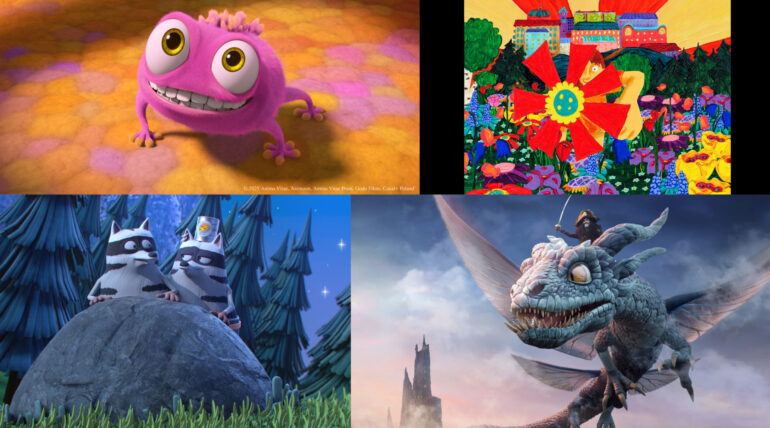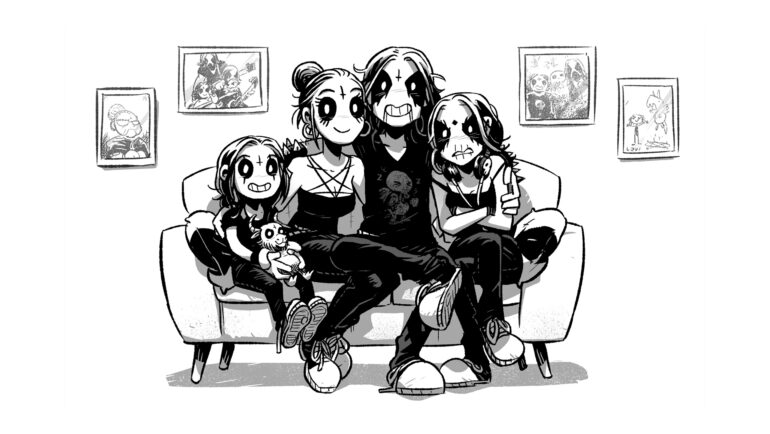WRITTEN BY: Marta Balaga
All roads lead to Annecy, at least in animation. As the festival wraps, Nordic professionals look at opportunities that spark new opportunities.
One of animation’s biggest gatherings wrapped its biggest edition on Sunday. The French event saw stars – Andy Serkis premiering Animal Farm, Michel Gondry talking about his career – and 18,200 badgeholders eager to throw paper planes at the screen and sneak a peek at the latest offerings from the biggest studios. But apart from celebration, there was also time for conversation – especially about the dangers of GenAI, with international animation unions ultimately staging a protest against its use.
Nordic creators, frequently spotted at the Nordic Animation stand at Annecy’s market MIFA, also wondered what’s to come, in between meetings.
Sweden’s Petter Lindblad, from Snowcloud Films and the Nordic Animation Association, observes: “What’s the situation now? That depends on whom you ask. There’s a finite amount of financing, but so many good projects and talented people. I see more animated projects getting money, because the institutes have been talking – they begin to see the crystallisation of certain partnerships across borders.”
“It helps to see that there’s business in animation,” he stresses. “There are new Nordic projects that seem to be saying: ‘Let’s see what we can do.’ We are good at adapting to technology, and there’s a storytelling culture in the Nordics that makes it easy to collaborate.”
Fleak, directed by Jens Møller and produced by Antti Haikala for Anima Vitae, has made its mark at the fest – also thanks to its purple protagonist, gifted to a couple of lucky audience members who couldn’t wait to take it home.
“The dragon is probably the only specific Nordic touch in the film,” notes Morali. “While we thrive on introducing Norwegian IPs to the world, we’re especially proud of the work we do at Qvisten Animation. We tell good stories that also look good.” Their short The Tomten and the Fox (Reven og Nissen), based on Astrid Lindgren’s tale, was awarded at Annecy in 2020.
Speaking of good stories: Jenny Jokela’s short Dollhouse Elephant picked up a prize at the fest, awarded the SACEM Award for Best Original Soundtrack in a Short Film.
“Most of us live in a society that’s very much centred on encouraging individual goals and achievements, and we see more and more of the world being destroyed and divided by lack of empathy and willingness to understand or even accept one another,” said Jokela.
She decided to focus on a “microcosm of a society”: a building shared by a group of nameless neighbours, who aren’t exactly interested in each other, even though they influence each others‘ lives.
“I knew from the start I didn’t want to use dialogue, but as human nature is a central theme, I still wanted to use the human voice as a leading part of the sound universe. I asked Sebastian Hilli to compose a non-verbal choir piece, with the idea that every neighbour has their own sound. They mix with each other in different ways, depending on whether the characters’ interactions are positive or negative.”
This is Jokela’s fourth work selected for Annecy, and she’s currently working on her first film with dialogue, embracing her Finnish-Swedish dialect.
“I enjoy films that feel authentic to the filmmaker. Most of my films include visual references to Finnish culture. In Dollhouse Elephant, the design of the buildings is inspired by Helsinki, and one character is cooking a fish soup, which is a very Finnish dish. Having said that, I’ve lived my adult life in the UK, so it has become a bit of a mixture between the British and the Finnish.”
Despite quite a few Nordic shorts in the lineup, including the musical 9 Million Colours (9 milionu barev), about a murderous mantis shrimp, co-produced by Norway’s Trollfilm, local artists do worry, admits Vesa Vehviläinen (aka one part of the creative duo Pink Twins, the creators behind Firewalk).
“The current government in Finland is the first in history to implement severe cuts to culture and arts funding. This makes working difficult and sometimes impossible. For independent and marginal artists, this is possibly not as lethal – we are used to small budgets. It will obviously change with the next elections, but it will take a long time to repair the damage.”
Still, between ambitious shorts and more commercially minded features, more arthousey, adult-friendly full-length films are missing.
“It’s hard to fund ‘arty’ features, and we don’t really have the audience for adult animation. But there’s more YA content coming soon. Also, Fleak is not your average Disney film. There are some darker or more serious themes in the story as well,” observes Olli Nurminen from Audiovisual Producers Finland, also mentioning the film Belzebubs.
Developed by Pyjama Films, this is a “family sitcom with a satanic twist”, says the company’s CEO and founder Terhi Väänänen.
“This story is even more popular abroad. It’s cute and dark, and it represents an extreme minority; a satanic family. They are underdogs, and we always love underdogs. It’s all about reaching for your dreams when the world is trying to stop you.” Starting with a series, a feature film is also looming on the horizon. “In Denmark, they had Flee (Flugt), but animated features for adults in Finland aren’t really happening at the moment. It’s rare to be able to develop one when it’s based on an original idea.”
However, darker tones and a bit of dry humour might be just what the buyers want, hopes Juha Fiilin from Fiilin Good Films, developing a psychological horror set in the Nordics, and anime influenced. “There’s a feature film and video game in early development, too. It’s certainly more indie, and a different voice. We are thinking about producing it with a game engine software and making it a pan-European co-production.”
Clara Sætren, project manager for Nordic Animation and Festival Producer at Fredrikstad Animation Festival, argues: “In Norway, animated features do well – in Norway. But maybe they’re just not finding the right distributors?”
She adds: “One person said to me: ‘The Nordics make family films a parent wants to sit through.’ They resonate with all ages. I grew up with Shrek, and when I watch these films now, they’re still very funny to me as an adult. Some of the Nordic films do that as well. We are already showing two features at Annecy. Opportunities like that will spark more opportunities.”
Leevi Lemmetty, fresh off showing Stories from Backwoods in TV Films Competition – about Rooney the Raccoon sent to become a park ranger in unruly backwater woods – notes: “I can see us becoming more recognised in the future. There is some great talent here. I would hope we could provide the needed funding to grow the business and studios, and for animation to be recognised more as a cinematic art form that can make an impact around the world.”
But industry professionals are turning to the Nordics not just for stories.
“The questions we’ve been getting the most at the stand this year had to do with people looking for co-production opportunities and minority co-producers. The Nordics are known for efficiency,” Sætren sums it up.


